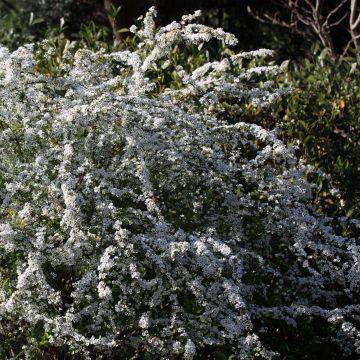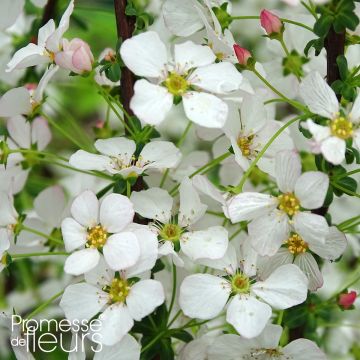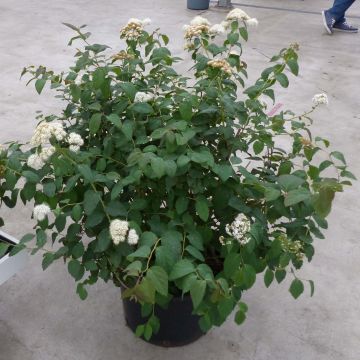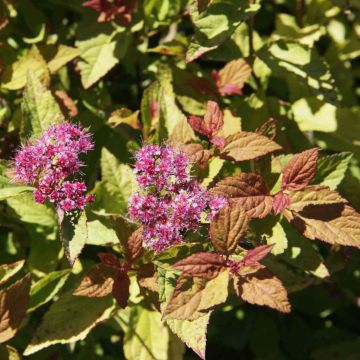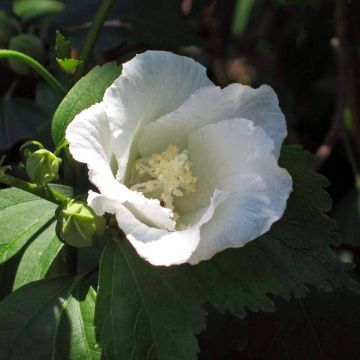

Spirée japonaise White Carpet - Spiraea nipponica
Spiraea nipponica White Carpet
Spiraea nipponica White Carpet (Gelspir)
Tosa Spiraea
Special offer!
Receive a €20 voucher for any order over €90 (excluding delivery costs, credit notes, and plastic-free options)!
1- Add your favorite plants to your cart.
2- Once you have reached €90, confirm your order (you can even choose the delivery date!).
3- As soon as your order is shipped, you will receive an email containing your voucher code, valid for 3 months (90 days).
Your voucher is unique and can only be used once, for any order with a minimum value of €20, excluding delivery costs.
Can be combined with other current offers, non-divisible and non-refundable.
Why not try an alternative variety in stock?
View all →This plant carries a 24 months recovery warranty
More information
We guarantee the quality of our plants for a full growing cycle, and will replace at our expense any plant that fails to recover under normal climatic and planting conditions.
Would this plant suit my garden?
Set up your Plantfit profile →
Description
The 'White Carpet' Japanese Spiraea is a modest-sized bush with a diffuse habit, both upright and spreading, which gives it all its elegance and originality. It is also appreciated for its massive flowering in June, with white garlands covering its flexible branches like a carpet of snow. When not in bloom, it surprises with its luxuriant rounded foliage symmetrically arranged along each stem, and delights with its beautiful golden colours in autumn. This late-flowering and late-foliage bush is easy to grow in most regions, including in cold climates.
The 'White Carpet' Japanese Spirea (Gelspir), quite rare in cultivation, belongs to the Rosaceae family. Its ancestor, Spiraea nipponica, is a vigorous bush native to the island of Shikoku, Japan. This bush has a moderately fast growth rate, and its mature size rarely exceeds 1m (3ft) in all directions. The 'White Carpet' Japanese Spiraea has a unique habit, both upright and spreading, supported by sturdy erect branches that are barely bent by the weight of the flowers. The very generous flowering, quite late for a spring spiraea, takes place in June. It covers the bush with countless small white bouquets, in flattened corymbs measuring 2 to 4 cm (1 to 2in), made up of small single flowers. They attract many insects and butterflies. The foliage is glossy, composed of small alternate, rounded, single leaves measuring 1 to 3 cm (1in) in length, dark green and shiny on the upper side and bluish underneath. Flowers and leaves appear on the same side of the arching branches. This spiraea acquires golden hues in autumn.
The 'White Carpet' Japanese Spirea will adapt to all climates and all soils, but dislikes dense shade or excessively hot or arid situations. The bush looks superb planted alone, in an informal hedge, in large borders, or in a bed. It can also be used in combination with trees and/or shrubs, or to fill a large slope. Accompany this small spiraea with e.g. dwarf buddleias, evergreen ceanothus, Physocarpus 'Summer Wine', Leycesteria formosa, or Japanese quinces. This spiraea also adapts very well to container cultivation, to decorate the terrace.
The word Spiraea means "curl" or "garland" in Greek; legend has it that the queen of the meadows used these flowers to make garlands. It was in the 16th century that the botanist Charles de l'Escluse attributed the name Spiraea to the entire genus. The nipponica species is native to Japan, and the Japanese spiraea was recently introduced. It was discovered by the German naturalist Siebold in 1885 but was only introduced to Europe in 1908. It has been used to create several cultivars.
Spiraea nipponica White Carpet in pictures


Plant habit
Flowering
Foliage
Botanical data
Spiraea
nipponica
White Carpet (Gelspir)
Rosaceae
Tosa Spiraea
Cultivar or hybrid
Other Spiraea
View all →Planting and care
Plant Japanese Spiraea 'White Carpet' in any soil that is not too alkaline, dry to moist, well-drained, preferably in full sun or partial shade. It will adapt to all climates and all types of soil, but it dislikes dense shade or extremely hot or arid conditions. Water well in the first year. This plant blooms on one-year-old branches. Pruning therefore, if necessary, should be done sparingly, by removing one-third of the flowering branches every other year just after flowering, to avoid missing out on flowers in the following spring. Light pruning promotes a slight repeat flowering. Apply a complete fertiliser in March. Plant out leaving a spacing of 80 cm (32in).
Planting period
Intended location
Care
Planting & care advice
This item has not been reviewed yet - be the first to leave a review about it.
Similar products
Haven't found what you were looking for?
Hardiness is the lowest winter temperature a plant can endure without suffering serious damage or even dying. However, hardiness is affected by location (a sheltered area, such as a patio), protection (winter cover) and soil type (hardiness is improved by well-drained soil).

Photo Sharing Terms & Conditions
In order to encourage gardeners to interact and share their experiences, Promesse de fleurs offers various media enabling content to be uploaded onto its Site - in particular via the ‘Photo sharing’ module.
The User agrees to refrain from:
- Posting any content that is illegal, prejudicial, insulting, racist, inciteful to hatred, revisionist, contrary to public decency, that infringes on privacy or on the privacy rights of third parties, in particular the publicity rights of persons and goods, intellectual property rights, or the right to privacy.
- Submitting content on behalf of a third party;
- Impersonate the identity of a third party and/or publish any personal information about a third party;
In general, the User undertakes to refrain from any unethical behaviour.
All Content (in particular text, comments, files, images, photos, videos, creative works, etc.), which may be subject to property or intellectual property rights, image or other private rights, shall remain the property of the User, subject to the limited rights granted by the terms of the licence granted by Promesse de fleurs as stated below. Users are at liberty to publish or not to publish such Content on the Site, notably via the ‘Photo Sharing’ facility, and accept that this Content shall be made public and freely accessible, notably on the Internet.
Users further acknowledge, undertake to have ,and guarantee that they hold all necessary rights and permissions to publish such material on the Site, in particular with regard to the legislation in force pertaining to any privacy, property, intellectual property, image, or contractual rights, or rights of any other nature. By publishing such Content on the Site, Users acknowledge accepting full liability as publishers of the Content within the meaning of the law, and grant Promesse de fleurs, free of charge, an inclusive, worldwide licence for the said Content for the entire duration of its publication, including all reproduction, representation, up/downloading, displaying, performing, transmission, and storage rights.
Users also grant permission for their name to be linked to the Content and accept that this link may not always be made available.
By engaging in posting material, Users consent to their Content becoming automatically accessible on the Internet, in particular on other sites and/or blogs and/or web pages of the Promesse de fleurs site, including in particular social pages and the Promesse de fleurs catalogue.
Users may secure the removal of entrusted content free of charge by issuing a simple request via our contact form.
The flowering period indicated on our website applies to countries and regions located in USDA zone 8 (France, the United Kingdom, Ireland, the Netherlands, etc.)
It will vary according to where you live:
- In zones 9 to 10 (Italy, Spain, Greece, etc.), flowering will occur about 2 to 4 weeks earlier.
- In zones 6 to 7 (Germany, Poland, Slovenia, and lower mountainous regions), flowering will be delayed by 2 to 3 weeks.
- In zone 5 (Central Europe, Scandinavia), blooming will be delayed by 3 to 5 weeks.
In temperate climates, pruning of spring-flowering shrubs (forsythia, spireas, etc.) should be done just after flowering.
Pruning of summer-flowering shrubs (Indian Lilac, Perovskia, etc.) can be done in winter or spring.
In cold regions as well as with frost-sensitive plants, avoid pruning too early when severe frosts may still occur.
The planting period indicated on our website applies to countries and regions located in USDA zone 8 (France, United Kingdom, Ireland, Netherlands).
It will vary according to where you live:
- In Mediterranean zones (Marseille, Madrid, Milan, etc.), autumn and winter are the best planting periods.
- In continental zones (Strasbourg, Munich, Vienna, etc.), delay planting by 2 to 3 weeks in spring and bring it forward by 2 to 4 weeks in autumn.
- In mountainous regions (the Alps, Pyrenees, Carpathians, etc.), it is best to plant in late spring (May-June) or late summer (August-September).
The harvesting period indicated on our website applies to countries and regions in USDA zone 8 (France, England, Ireland, the Netherlands).
In colder areas (Scandinavia, Poland, Austria...) fruit and vegetable harvests are likely to be delayed by 3-4 weeks.
In warmer areas (Italy, Spain, Greece, etc.), harvesting will probably take place earlier, depending on weather conditions.
The sowing periods indicated on our website apply to countries and regions within USDA Zone 8 (France, UK, Ireland, Netherlands).
In colder areas (Scandinavia, Poland, Austria...), delay any outdoor sowing by 3-4 weeks, or sow under glass.
In warmer climes (Italy, Spain, Greece, etc.), bring outdoor sowing forward by a few weeks.






























